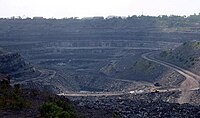
Photo from wikipedia
Coal and gas outbursts are related to the pore structure of coal, in order to study the pore characteristics of high-temperature coal mine and the impact of invasive water on… Click to show full abstract
Coal and gas outbursts are related to the pore structure of coal, in order to study the pore characteristics of high-temperature coal mine and the impact of invasive water on its development, the invasive water treatment and water bath process at the high temperature of coal samples taken from Yangliu Mine, Guqiao Mine, and Dingji Mine were carried out. The pore characteristics of the raw coal (R-coal) samples and invasive water coal (IW-coal) samples were analyzed through the mercury intrusion porosimetry (MIP) and CO2 gas adsorption testing. The results show that the pore connectivity in macropore phase is significantly better than that in mesopore stage. And the porosity, total pore volume, total surface area, and micropore ratio increase with the increase of R-coal rank. The mesopore ratio decreases as the R-coal rank increases, and macropore ratio has the trend of “decrease-increase” with the increasing R-coal rank. After the water intrusion into R-coal samples at high temperature, the porosity increases significantly, however, there is no effect on the pore connectivity. The total surface area, micropore ratio, and micropore volume of the coal samples decrease because of the invasive water, leading the adsorbed gas to convert into free gas. The total pore volume, mesopore ratio, and macropore ratio increase, increasing the channel of gas diffusion and permeability. The results provide a theoretical basis for exploring the effect of the invasive water on gas migration in the high-temperature coal mine.
Journal Title: Arabian Journal of Geosciences
Year Published: 2019
Link to full text (if available)
Share on Social Media: Sign Up to like & get
recommendations!